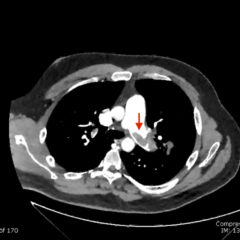Pectoralis Muscle Tendon Rupture
History of present illness:
A 43-year-old male presents to the emergency department with pain and weakness in his right shoulder for the past two weeks. He reports feeling a snap in his right shoulder and noticed an abrupt loss of strength in that arm while bench pressing fifteen days ago. Since that time, he endorses notable weakness and pain in his right arm with arm adduction. He has no history of previous arm or shoulder injury and denies any history of trauma
Significant findings:
There is a noticeable difference in appearance and location of maximal prominence of the right pectoral muscle with arms outstretched (image 1). This is accentuated by having the patient perform an isometric arm press. (image 2).There is absence of the anterior axillary fold with adduction against resistance. The stump of the pectoralis muscle was palpated along his armpit. He otherwise has full range of motion in the shoulder with minimal pain.
Discussion:
The pectoralis muscle is triangular in shape with a muscular belly with two heads; a clavicular head and a sternal head. These heads converge into a wide, flattened, two-layered, tendon that inserts into the humerus lateral to the bicipital groove.1 Pectoralis muscle tears are quite rare, with only around 400 cases noted in literature.2 They happen almost exclusively in males, likely due to males’ lower tendon elasticity and lower tendon to muscle ratio.3 They usually happen in men age 20-50 who engage in weight lifting, although cases have been reported with wrestling, gymnastics, rugby, football, hockey, windsurfing and parachuting.4 Pectoralis muscle tears are usually able to be diagnosed based on history and physical. Visual inspection of the chest will show loss of the anterior axillary fold; this can especially be noticed by having patients push their palms together causing an isometric contraction.5 There will often be ecchymosis on the area of the proximal humerus. Examination will show weakness of the affected arm with internal rotation and adduction.6 Radiographs of the affected shoulder can be useful to rule out bony avulsions; however, magnetic resonance imaging (MRI) is the definitive imaging choice because it can show both the location and extent of the injury.7 Treatment is divided between conservative and operative management. Conservative management is generally limited to older or sedentary patients or those with partial tendon or muscle belly ruptures.8 Operative repair is generally required in athletes due to poor outcomes reported from conservative management.9 The initial approach is to place the affected limb in a sling, in the adducted and internally rotated position, and to treat with cryotherapy and analgesia.6 The patient should be given a referral to be seen by orthopedics as soon as possible because best results are seen if surgically repaired within eight weeks of the injury.11
In this patient, subsequent MRI of the right shoulder shows a high-grade tear/avulsion of the humeral insertion right pectoralis major myotendinous junction with tendon retracted 4.1 cm medially and edema extending along the deltopectoral groove. Orthopedic surgery was consulted who recommended that patient be placed in a sling and discharged with a referral to follow up with orthopedics in clinic the following day. After evaluation, he underwent surgery the following week with successful operative repair.
Topics:
Pectoralis muscle, musculoskeletal injury, tendon rupture, orthopedics, sports medicine.
References:
- Fung L, Wong B, Ravichandiran K, Agur A, Rindlisbacher T, Elmaraghy A. Three-dimensional study of pectoralis major muscle and tendon architecture. Clin Anat.2009;22(4):500–508. doi: 10.1002/ca.20784
- ElMaraghy AW, Devereaux MW. A systematic review and comprehensive classification of pectoralis major tears. J Shoulder Elbow Surg.2012;21(3):412-422. doi: 10.1016/j.jse.2011.04.035
- Äärimaa V, Rantanen J, Heikkilä J, Helttula I, Orava S. Rupture of the pectoralis major muscle. Am J Sports Med. 2004;32(5):1256-1262.
- Kohen R, Warren RF, Rodeo SA. Pectoralis major tendon injury: an overview. Hospital for Special Surgery. https://www.hss.edu/conditions_pectoralis-major-tendon-injury-overview.asp. Published January 10, 2011 Accessed October 10, 2018.
- Wolfe SW, Wickiewicz TL, Cavanaugh JT. Ruptures of the pectoralis major muscle: An anatomic and clinical analysis. Am J Sports Med. 1992;20(5):587-593. doi: 10.1177/036354659202000517
- Provencher CM, Handfield K, Boniquit NT, Reiff SN, Sekiya JK, Romeo AA. Injuries to the pectoralis major muscle: diagnosis and management. Am J Sports Med.2010;38(8):1693-1705. doi: 10.1177/0363546509348051
- Carrino JA, Chandnanni VP, Mitchell DB, Choi-Chinn K, DeBerardino TM, Miller MD. Pectoralis major muscle and tendon tears: diagnosis and grading using magnetic resonance imaging. Skeletal Radiol. 2000;29(6):305-313.
- Schepsis AA, Grafe MW, Jones HP, Lemos MJ. Rupture of the pectoralis major muscle: outcome after repair of acute and chronic injuries. Am J Sports Med. 2000;28(1):9-15. doi: 10.1177/03635465000280012701
- de Castro Pochini A, Ejnisman B, Andreoli CV, et al. Pectoralis major muscle rupture in athletes: a prospective study. Am J Sports Med. 2010;38(1):92-98. doi: 10.1177/0363546509347995
- Bak K, Cameron EA, Henderson IJ. Rupture of the pectoralis major: a meta-analysis of 112 cases. Knee Surg Sports Traumatol Arthrosc. 2000;8(2):113-119. doi: 10.1007/s001670050197




